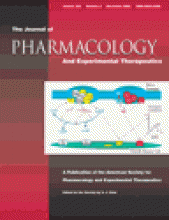Abstract
Although certain antiparkinson agents interact with serotonin (5-HT) receptors, little information is available concerning functional actions. Herein, we characterized efficacies of apomorphine, bromocriptine, cabergoline, lisuride, piribedil, pergolide, roxindole, and terguride at human (h)5-HT1A, h5-HT1B, and h5-HT1D receptors [guanosine 5′-O-(3-[35S]thio)triphosphate ([35S]GTPγS) binding], and at h5-HT2A, h5-HT2B, and h5-HT2C receptors (depletion of membrane-bound [3H]phosphatydilinositol). All drugs stimulated h5-HT1A receptors with efficacies (compared with 5-HT, 100%) ranging from modest (apomorphine, 35%) to high (cabergoline, 93%). At h5-HT1B receptors, efficacies varied from mild (terguride, 37%) to marked (cabergoline, 102%) and potencies were modest (pEC50 values of 5.8–7.6): h5-HT1D sites were activated with a similar range of efficacies and greater potency (7.1–8.5). Piribedil and apomorphine were inactive at h5-HT1B and h5-HT1D receptors. At h5-HT2A receptors, terguride, lisuride, bromocriptine, cabergoline, and pergolide displayed potent (7.6–8.8) agonist properties (49–103%), whereas apomorphine and roxindole were antagonists and piribedil was inactive. Only pergolide (113%/8.2) and cabergoline (123%/8.6) displayed pronounced agonist properties at h5-HT2B receptors. At 5-HT2C receptors, lisuride, bromocriptine, pergolide, and cabergoline were efficacious (75–96%) agonists, apomorphine and terguride were antagonists, and piribedil was inactive. MDL100,907 and SB242,084, selective antagonists at 5-HT2A and 5-HT2C receptors, respectively, abolished these actions of pergolide, cabergoline, and bromocriptine. In conclusion, antiparkinson agents display markedly different patterns of agonist and antagonist properties at multiple 5-HT receptor subtypes. Although all show modest (agonist) activity at 5-HT1A sites, their contrasting actions at 5-HT2A and 5-HT2C sites may be of particular significance to their functional profiles in vivo.
Footnotes
-
DOI: 10.1124/jpet.102.039883
- Abbreviations:
- 5-HT
- serotonin
- DA
- dopamine
- l-DOPA
- l-dihydroxyphenylacetic acid
- [35S]GTPγS
- guanosine 5′-O-(3-[35S]thio)triphosphate
- h
- human
- PI
- phosphatidylinositol
- CHO
- Chinese hamster ovary
- Received June 14, 2002.
- Accepted July 22, 2002.
- The American Society for Pharmacology and Experimental Therapeutics
JPET articles become freely available 12 months after publication, and remain freely available for 5 years.Non-open access articles that fall outside this five year window are available only to institutional subscribers and current ASPET members, or through the article purchase feature at the bottom of the page.
|






